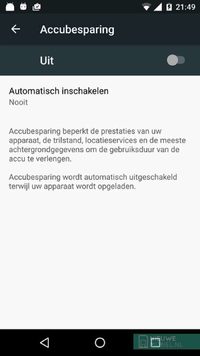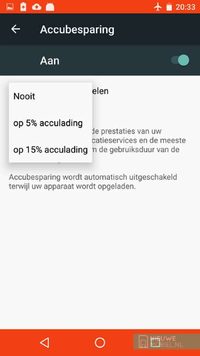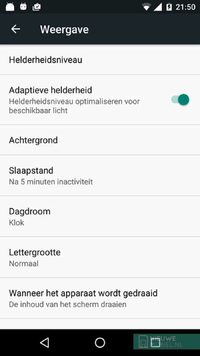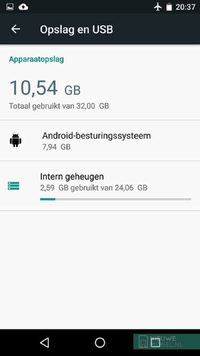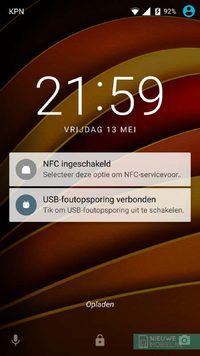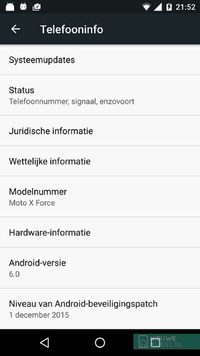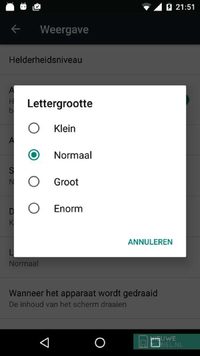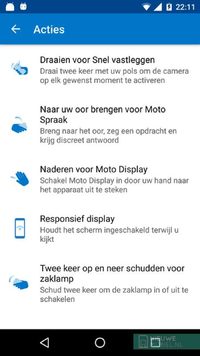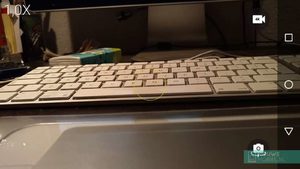Motorola Moto X Force review
Unbreakable with not so standard Android
Have you had to have your phone's screen repaired countless times? Then Motorola now has a device that's perfect for you.

After one type of Moto X in 2013 and 2014, Motorola has released no less than three in 2015. Of these, the Moto X Force is the last one at the time of writing and the most powerful in terms of hardware. This makes it the best Motorola has to offer at the moment. The Moto X Force has a screen with Quad HD resolution, octacore processor, 21 megapixel camera, 32 GB of memory with space for a microSD card and a large battery.
With the Force, Motorola wants to put an end to cracked and broken screens on your smartphone. An accident is in a small corner, and your phone can go wrong in the event of a fall and you'll need to have the screen replaced or buy a new device. With a new technology for the screen, this shouldn't happen again on Moto X Force.
Content of the box
Quick charger
Manual
The Force was already in a pretty high price range when it was launched and if you look at the competition now, it still is. For example, the LG V10, another smartphone where extra attention has been paid to robustness, has dropped below 500 euro after the same launch price of 700 euro. If you are mainly interested in pure Android then you should of course consider the Nexus 6P and 5X. These are both cheaper than the Moto X Force. The same goes for the Moto X Style and Play. Although the latter three differ significantly on certain aspects of the hardware.
Design
The Moto X Force is only available in black and this colour can be seen on the front and back. It has a metal frame around it with the on/off and volume buttons slightly recessed on the right side. At the top of the device is the headset port and a drawer with space for the SIM and a second SIM card or a microSD card. On the bottom we find a microUSB port. On top of the metal frame is a plastic rim with a glass plate that covers the entire front of the device. In contrast to most other high-end smartphones, this is not Gorilla Glass but the ShatterShield developed by Motorola. Motorola guarantees that this will not break for up to four years after purchase. This does not alter the fact that it can scratch. Something that happened to us as well.

Under the screen there are two slots in the glass, each with a grid. The left one is apparently in front of the microphone because only the right one houses a loudspeaker. This is not really a nice solution and we would have preferred Motorola to use the same kind of design as for the ear loudspeaker above the screen. As we also saw on most other Motorola devices there is a metal ledge in the slot above the screen with a number of sensors next to it and on the far right and left the selfie camera and an LED flash.
The space for the 5.4 inch screen is not so much in the length but more in the width of the device. Since the edges next to the screen are quite wide, the device itself is also a bit on the wide side. This makes it more difficult to hold it with one hand. Moreover, the screen-to-body ratio is less than 70%.

The back of the Force is flat and sloping towards the sides. In the middle is the typical Motorola metal plate that sticks out a little bit. It contains a round dimple with the Motorola logo and above it a two-tone LED flash and the camera. Motorola has made a habit of covering the back of its devices with unusual materials. We saw leather, wood and bamboo on earlier Moto X cameras. The back of the Moto X Force is covered with a woven plastic material that looks a bit like kevlar. This looks special, feels comfortable and is insensitive to dirty or sweaty hands. However, it doesn't offer any grip at all, which is important for a larger and heavier machine like the Moto X Force.
The Force is the thinnest of the three Moto X's, but with a thickness of almost one centimetre it's still not really slim. Its weight is firm but not above average. We wouldn't call the Moto X Force a paragon of beauty. It's a bit coarse and unwieldy design after all.
Performance
The Moto X Force's battery has a capacity of 3760 mAh and in combination with the AMOLED screen we expected a robust endurance. With a screen on time of five hours, we were able to complete a 48-hour period of use. When a screen on time of six hours is needed, it will last another 1.5 days or so. As Motorola promises 30 hours of use, this is certainly more than adequate. With the help of the quick charger the battery will be full again in more than 1,5 hours.
The usage time is partly achieved because Android 6.0 includes the so-called 'Doze' function. This ensures that the device goes into a sleep mode when it is idle for some time. As a result, notifications can come in a little later, but the consumption also drops to a few percent spread over a considerable number of hours. There is also a battery saving function that can automatically switch on at 5 or 15 percent remaining battery charge. This reduces device performance, vibration, location services and most background data.
".
As the Moto X Force is a 2015 device, it is still powered by Qualcomm's Snapdragon 810 processor. This was long known as a worry child due to overheating, but has also proven to be a strong source of power. In combination with 3 GB of working memory, the Force certainly stands his ground.
Screen
Unlike the Moto X Style and Play, the Force is equipped with an AMOLED display. With a resolution of 2560 × 1440 pixels, this provides a very detailed and vivid image. Colours are a lot deeper than on a regular LCD screen. When the Moto X Force is held next to another device, the screen may appear a bit yellowish, but normally it doesn't really bother you. With pure Android, it is not possible to make adjustments to the image. However, there is an option under Accessibility where you can correct colours for people who suffer from a specific form of colour blindness.
".
The brightness for Motorola's AMOLED displays is often adjusted rather darkly, and this is also the case on the Moto X Force. This is of course beneficial for endurance, but we preferred to set the brightness to 40-50 percent with adaptive brightness on. At the same time, this adaptive mode doesn't dim the screen to the minimum when it's completely dark around you.
Hardware
Motorola hasn't released any devices with a fingerprint scanner at the time of writing, so the Force will have to do without that technique as well. For a contemporary flagship this is starting to become a bit of a shortcoming. Although a fingerprint scanner could also conflict with the operation of Moto Display. Still, rumours suggest that later this year we will see fingerprint scanners in new aircraft from Motorola.
Watertightness is not a superpower of the Force, but by means of a water repellent coating it should also be able to withstand an accident in this area. In the Netherlands, the Force is only available with 32 GB of storage memory. More than 24 GB of this is available to the user as internal memory.
Software
Motorola's devices run on a largely standard version of Android. We applaud this because apart from looking good, it also ensures that devices can be updated relatively quickly. Another important advantage is that you don't have double apps with the same functionality on the device. The Moto X Force was launched with Android 5.1 but now runs on Android 6.0.
".
On Moto X Force, too, you have up to five home screens available, the leftmost of which is the home screen. By swiping left once more, Google Now appears with lots of updates on separate maps that may be of interest to you. Another way to open Google Now is to press and hold the home key. The application menu is a continuous list that can be scrolled through vertically. At the very top there is also a search bar with a line for the four most frequently used apps. This line can also be turned off in the Google settings. The screen with shortcuts to settings such as WiFi and Bluetooth, but also a flashlight, is located above the notification window. This means that notifications appear by dragging the status bar downwards but to get to the settings you have to repeat this movement again or swipe down with two fingers at the same time. The lock screen also shows notifications. These can be swiped away or you can open the corresponding app directly by tapping it twice. You can also quickly open a voice search or the camera from the lock screen.
".
Yet, unfortunately, there are also differences compared to pure Android. For example, the level of the security patch is still on December 1 (more than 5 months after writing this review) while a Nexus device is updated monthly. It's not clear when or how often Motorola will perform updates. In the software, the QHD resolution of the screen does not really come into its own either. Much of the interface looks a bit bloated. The grid size on the start screen is 4x4 while on the Nexus 5X with its smaller screen is 5x5. In apps like the Play Store or Gmail there is also relatively little content on screen. This can be remedied to some extent by setting the font size in the display settings to small but it's not really satisfactory.
".
Gmail is currently the only email application on the Force. This is because in addition to your Google account, Gmail can also sync with other email accounts. Such as Yahoo, Outlook or Exchange. Mail from different accounts can be displayed in a combined mailbox. As with Gmail, messages from POP3, IMAP, and Exchange accounts can be grouped as conversations.
The app for SMS and MMS is the old messaging application and not the new Messenger app. It can be installed but the old one cannot be switched off. The calculator has recently been updated by Google but cannot be run on Moto X Force. Instead the app will be installed separately. The phone and contacts app are now also installed separately in the Play Store. These can be installed but they don't work or don't work at all.
".
These may seem futile details and we may be overly sensitive to them, but it's good to know that Android on the Moto X Force is not as standard as it seems at first glance. It doesn't make the Force work any less, but the beauty of, for example, the separate apps in the Play Store is that you can easily update them. On the other hand, Motorola also adds some functionality itself.
".
The most beautiful of these is Remote Moto Display. This is found in the Moto-app and shows in white the time and notifications on the screen when they come in or when you move your hand towards the device while the screen is turned off. Because on an AMOLED screen the black parts don't have to light up, it takes very little energy. From the notification, the corresponding app can be opened directly without first turning on the screen. Furthermore, the device can be controlled with movement and voice to perform certain actions or open applications. Unfortunately Moto Voice is not supported in Dutch. In fact, if you want to use it, you will have to change the system language to English, for example.
In addition, Connect and Help are installed on the device. The second will speak for itself, and the first allows you to pair an accessory with your Moto X Force via Bluetooth. Unfortunately this only works for specific Motorola accessories such as headsets and the Moto 360-smartwatch.
Camera
Motorola's cameras didn't have a good reputation, but with the arrival of the Moto X Style, that changed somewhat. The Force is equipped with the same 21 megapixel camera as the Style. Optical image stabilization is still not available.
The camera app is exchanged on Motorola devices for one of your own make. This interface is not really easy or intuitive to use. After booting up, only two buttons are visible. One to switch to the self-image camera and the other to record video. Furthermore, in the middle of the search window you can see a frame with a circle around it. By swiping in from the outside left of the screen, a dial comes into view for various setting options. Here HDR, flash, video and photo size, timer, panorama, location, shutter sound and quick capture can be adjusted. Furthermore, a question mark is visible in the upper right corner, which can be used to start a short explanation of how to operate the camera.
The camera can be started by turning the camera twice with your wrist in your hand. In this way you can also switch to the self-image camera. Taking a picture is done by tapping anywhere on the screen. If you want to change the focus, you have to drag the frame. After you have tapped the frame, the exposure can still be adjusted.
Once you have mastered the controls, you can take nice pictures with the Force. Exposure and color reproduction are well taken care of. This is helped by the automatic HDR mode. When there is less ambient light, some noise becomes visible, as you would expect. A photo is also moved much faster. Indoors, this can be counteracted to some extent by the two-tone flash without really overexposing the image.
Record normal video in HD and Ultra HD (4K) and slow motion video in 720p. The self-image camera has 5 megapixels but to take photos in widescreen only 3.8 megapixels are available.
Conclusion
The Moto X Force is a high-end smartphone with solid specifications and an unbreakable screen according to Motorola. But that's not all. The powerful processor, hefty battery, detailed screen and capable camera are packaged in a robust but not too excitingly designed shell. What's more, the Moto X Force isn't really handy, and it needs to be groped pretty deep in front of the pouch.
We applaud Motorola's choice of an almost standard version of Android, but it turns out there are a lot of deviations on details. These are not completely undone by the extra functionality Motorola adds. Should the unbreakable screen be the deciding factor for you anyway, you might also consider buying a more sharply priced device and spending the money saved on insurance for your phone or saving it for when the screen actually needs replacing.


